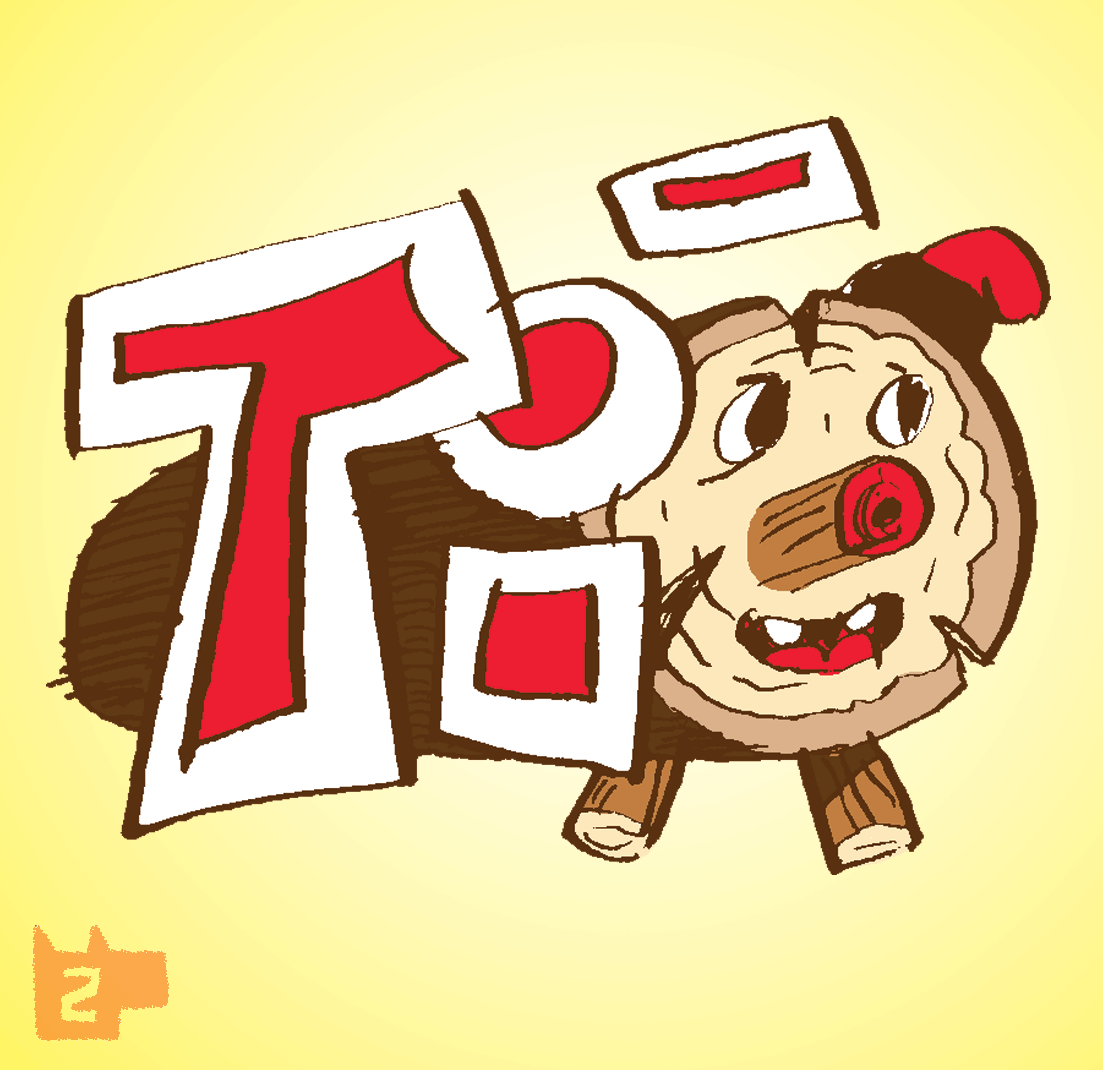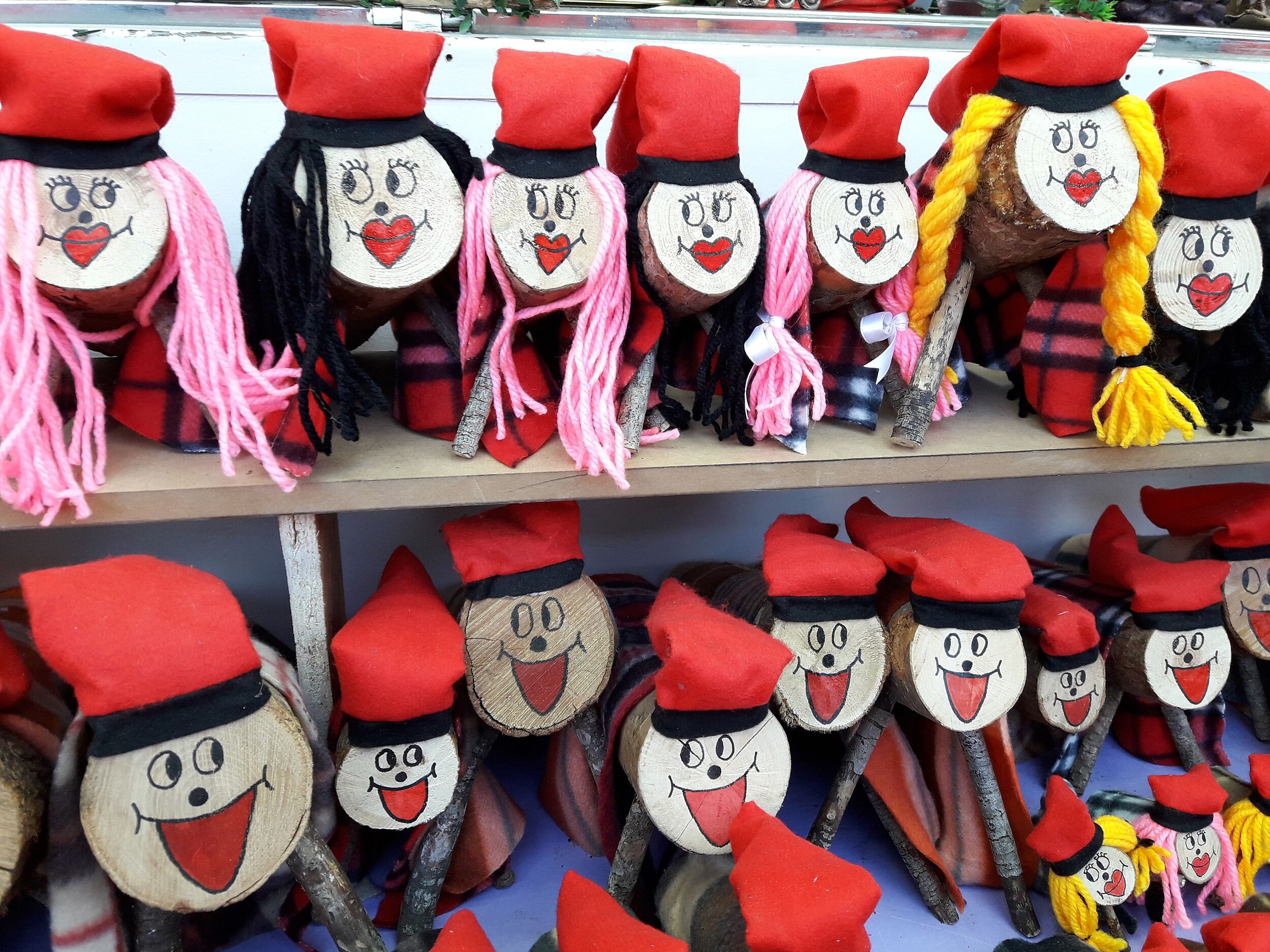Fig.1- ‘Tió de Nadal’.
Illustration copyright ZEEL.
Fig.2- Tió fan Charlotte and friend.
Photo copyright S.Bellan.
The Tió de Nadal or ‘Christmas Log’ of Catalonia and Aragon (at the moment regions of Spain), does seem to be more popular than Santa in those parts, and offers a fun, earthy activity for the family to share.
This is a collaborative report initiated by ZEEL with the Cremades–Bellan family of Barcelona, They are:-
Pep, he is from Valencia and grew up in Barcelona.
Sandrine, she is from France.
Plus daughter Charlotte, born and bred in Barcelona.
Together we here investigate the assertion that:-
“Tió Nadal is as big here in Catalonia Catalonia as Santa Claus is for you in the UK”.
The name of this popular arboreal entity is confusing to some, and mistranslated as Uncle Poop or suchlike. But this is incorrect, as in the Spanish language ‘Tio’ means ‘uncle’ or ‘guy. But in Catalan the word ‘Tió’ (with an accent on the “o”) means ‘log’ or ‘branch’. So it is actually called Tió de Nadal - ‘Log of Christmas’, and more colloquially Caga Tió - ‘Crapping Log’.
Though our local experts add a correction to this naming- Sandrine states :
”The log is called "Tió", not Caga Tió. We say - "“fer cagar el tió” or “make the log poo”.
As we can see from Fig.1 , Tió is indeed a log, and has little wooden legs, a traditional Catalan cap (or Barretina), a red nose and cheery googly eyes. A pipe and/or beard are optional additions.
Fig.3 - Tió the crapping log in situ with blanket.
Photo copyright S.Bellan
Every Catalan house has its own Pooping Log:
This Tió character is so popular in Barcelona that Charlotte has been monitoring many such logs. Not only in her own home, but also others located in her school and at the local swimming pool. How does it work in a school? Sandrine says:-
“The school asks it’s pupils families to bring in stuff to feed the log. Then all the food is put in different boxes for the lottery. We organise a lottery right before the xmas holidays selling lottery tickets to the parents to win the food that they have given to the log [the residue that he has not managed to consume]. This way the school gets money for any activities they may organise.”
The most epic example of Tió is this; there is even a giant one at the Fira de Santa Llúcia at the Cathedral of Barcelona. The equivalent of “Santas Grotto” in UK/USA.
Fig 4. Tió at Fira de Santa Llúcia, near the steps of the Cathedral of Barcelona.
How it works:
Tió arrives every 8th of December, which is the Feast of the Immaculate Conception to Roman Catholics. Often parents will supervise a hunt to find a Tió de Nadal in the countryside, in order to take it back home and feed it up for xmas. A Tió can be oft be found by following a trail of mandarin peel fragments. In Charlotte’s house, tió comes directly from the Pyrenees and can be found at her door, cold and hungry after his long journey.
Fig.5- The Hunt.
Illustration copyright ZEEL.
Fig.6- The Welcome.
Illustration copyright ZEEL.
Tió is welcomed in. Traditionally, from Dec 8 till Dec 24 food is given to the Tió, often served in a small red pottery bowl of local manufacture. Tió is fed a wholesome diet that consists of vegetable peelings and the peel of satsuma oranges for the first weeks, and then, as the great day grows ever nearer, getting closer to Christmas, cookies and finally turron are introduced to the diet, to make sure that Tió will crap many presents on Christmas Eve. Children always want to see the Tió eating to make sure this is not a fake event, so there are videos on YouTube that monitor the log at night with realistic looking night-vision cameras and (click for video) ultra highspeed video playback technology.
Fig.7-Installation of Log.
Illustration Copyright ZEEL.
Tió normally stands close to the Christmas tree with a small blanket drawn up to his shoulders, all warm and cosy until the time comes for the main pooping event on Christmas Eve, or Christmas Day. If you are an especially inquisitive child and you look under the blanket before the correct moment, you will see nothing, nada, zip. Because Tió has not pooped yet, of course!
Fig.8-The Feeding and husbandry of an honoured log.
Illustration copyright ZEEL.
To get the Tió to poop out presents you need to beat it with sticks, and to sing a special song!
But first, all children are asked to leave the room to sing and warm up some special beating sticks, and at more traditional times and places, to pray.
Fig.9-The warming of the sticks.
Illustration copyright ZEEL
After a while the kids are called back to the tree, and, singing a song (this is one of many versions) they beat the Tió entreating it with song to poop out presents.
“Cagatió,
cagatorrons, avellanesi
mató,
si no caguesbé
et daré un cop de bastó.
Cagatió!
Translation-
"Shit log,
shit nougat, hazelnuts and
cheese,
if you don’t shit well,
I’ll hit you with a stick.
Shit log!”
Fig.10-The Beating.
Illustration copyright ZEEL.
After singing the song thrice while beating Tió, the children are finally allowed to remove the blanket, and to extract the gifts as just reward for their investment of effort in the husbandry and fattening-up of a present pooping Xmas log. Sometimes Tió is hollow in form and the beating he is given is sufficient to dislodge the treats from his woody alimentary canal, sometimes the treats just appear in a semi mystic manner under the blanket at just the right time.
Fig.11-The big reveal.
Illustration copyright ZEEL
What the last poop out of Tió consists of depends on family tradition. Sandrine says
“We leave a bean, other families leave a pinecone”,
other sources indicate that an onion or clove of garlic ‘coming down the pipe’ indicates that Tió has completed his duty (source here).
A few notes on the history of this tradition.
Pep never celebrated it in his home when he was a kid. Apparently, it seems to him that the shitting log really appeared in the 60's (Even though the essence is from the Middle Ages), and it was confirmed by many friends of his generation that they only have started to celebrate the Tió with their children, that is, within the last 21 years. Could it be that Tió is merely a recent conflation of several different traditions and? He certainly seems to contain aspects of –
Caganer A pooping figurine that appears in traditional nativity scenes in this region of the Iberian Peninsula.
Piñata The ancient practice of hitting a suspended effigy of an animal until sweets or little gifts are released, thought to have originated from China. First seen in Europe in the 14th C.
Yule log The (possibly Germanic and pagan) practice of collecting and burning a special log at the time of the winter solstice.
Fig.12- Nens_fent_cagar_el_Tió-
Illustrator unknown. Drawing from the magazine La Llumanera de Nova York. - Catalan Wikipedia. Viquipèdia in català.
BUT! This old illustration of some children wearing Catalan Barretina caps beating a log seems to indicate that the tradition has roots that stretch to before the 1960’s, though this Tió has no legs and only the slightest suggestion of a face.
Fig.13 - Author Joan Amades https://alchetron.com/Joan-Amades
Catalan author Joan Amades specialized in writing and collecting Catalan folklore. He wrote many volumes and articles about festes tradicionals. Amades multi-volume book Costumari Català (a collection of Catalan customs, 1950–1956) is acknowledged as a most important repository of information about Catalan customs, and of course, there is a section about the Tió.
So Tió seems to be a tradition with some provenance, but why to friends living in Barcelona, does it seem to them that it did not happen before the 1960’s? Maybe this is due to larger forces at work? Our Barcelona team made enquiries with brother in law Ferran Puchaes, 55 years old and coming from a proudly Catalan family. According to Ferran, if you were living in Barcelona during the time of the Franco regime (1936 – 1975), even if you were Catalan you were much less likely to be brought up with Catalan traditions like Tió de Nadal. It all depends whether you were inhabiting Barcelona or small towns in the hinterland of Catalonia. In the 1960's Franco was still very present in the life of the Barcelonese, and the way that the regime embraced strict Catholicism and sought to homogenise every area of Spain culturally meant that traditions that were not directly affiliated with that ideology were repressed, so Tió was not welcome. But in small villages, even Franquist mayors were Catalan speakers... So the Tió survived in the remotest parts of Catalonia as the gaze of the dictatorship did not fall there, or was maybe casting a blind eye.
Current issues
Sandrine reports:
“When my daughter Charlotte was younger, maybe 3 years old, she did not want the « Tió » to leave. So to free him from staying in our living room the entire year, we had to invent a whole back-story, so now in our family myth Tió has a wife and a son waiting for him back home in the Pyrenees”.
Fig.14 -The return.
Illustration copyright ZEEL.
Another issue with the care of xmas logs is this - you must be available to feed him!:-
Sandrine says:-
“We are going to Paris this year at Christmas and this is an issue in regard to Tió-care. When I told Charlotte the Tió would not poo this year, this was a BIG DEAL. Charlotte said she did not want to go to Paris. To abandon Tió, how dare we? I tried to explain to her that the road would be long for the Tió as from the Pyrenees to Paris there is a big distance and that I had never seen a log taking the TGV [high-speed train service] by itself…
So guess what? We are going to Paris with the Tió. Charlotte has offered to carry him. We hope there will not be any hold-up when French border-officers see the shape of Tió on the x-ray scanner!”
Does Log beat Santa?
Another piece of anecdotal evidence of the pre-eminence of Tió over other Xmas traditions in these parts is this:
“A Scottish friend of the family had a daughter who was born here in Barcelona and stopped believing in Santa Claus a long time ago. But until a relatively advanced age (8-9 years) she was still very much a believer. Her mother was worried”.
The Judgement.
To us here at Golden Thread Project HQ it does seem much more fun and less passive than the northern traditions of writing a letter to Santa and then sitting about waiting, hoping that you have been good enough to merit a gift. So we may judge that Tió is indeed a worthy competitor to Saint Nick.
Appendix-
Digital style Tió from the game “Crossy Road” https://crossyroad.fandom.com/wiki/Ti%C3%B3_de_Nadal
“Tiótia” female Tió effigies are also available.
Sandrine and Tió en masse for purchase in Barcelona store.
Photo copyright S.Bellan
Links and sources-
You Tube night vision Tió surveillance:
History - BBC Mundo - https://www.youtube.com/watch?v=Xa9EnGqaT0s&fbclid=IwAR1fUA1IGO-Ty7mz-d7u9CS7-muzjOIsvNiUg6bYEkobxW-CjocAxMWghuY
Other evidence-
A final thought- is the traditional English ‘Tree Wassailing’ a parallel to the beating of Tió ?–https://www.whitedragon.org.uk/articles/wassail.htm

















